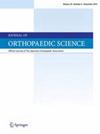内侧半月板退行性撕裂与内侧半月板挤压动力学的超声相关性研究。
IF 1.4
4区 医学
Q3 ORTHOPEDICS
引用次数: 0
摘要
背景:评估退行性半月板撕裂与内侧半月板挤压的相关性对于确定早期膝关节骨关节炎的适当治疗方案是必要的。本研究利用超声检查评估早期膝关节骨关节炎患者退行性半月板撕裂与内侧半月板挤压的关系。方法:对123例早期膝关节骨性关节炎患者的132个膝关节进行回顾性评价。内侧半月板在膝关节屈曲角度为0°和90°时挤压,以及半月板退行性撕裂,采用超声和磁共振成像进行评估。将内侧半月板挤压分为4个等级,将退行性半月板撕裂分为5种类型:0型,无撕裂或只有退行性改变;1型,仅在内侧半月板后段水平撕裂;2型,内侧半月板后段和中间段均出现水平撕裂;3型,皮瓣撕裂或内侧半月板浸渍;4型,内侧半月板后根撕裂或桡骨撕裂。评估各半月板撕裂组中半月板撕裂类型与内侧半月板挤压程度的相关性。结果:半月板撕裂类型与内侧半月板挤压程度显著相关(r = 0.518, p = 0.001)。2级或3级内侧半月板挤压(即内侧半月板在膝关节屈曲角度为0°时挤压bbb30 mm)的比例分别为23.8%、50.0%、86.8%、94.1%和92.3%。0-4型患者内侧半月板在膝关节屈曲角度为0°和90°时挤压bbb30 mm的比例分别为0%、20.0%、52.6%、70.6%和50.0%。结论:半月板退行性撕裂越严重,半月板内侧挤压越大,早期膝关节骨性关节炎动力学异常越多。本文章由计算机程序翻译,如有差异,请以英文原文为准。
Correlation between medial meniscus degenerative tears and medial meniscus extrusion and dynamics using ultrasonography
Background
Evaluating the correlation between degenerative meniscus tears and medial meniscus extrusion is necessary to determine the appropriate treatment plan for early-stage knee osteoarthritis. This study evaluated the relationship between degenerative meniscal tears and medial meniscus extrusion in early-stage knee osteoarthritis by using ultrasonography.
Methods
A total of 132 knees from 123 patients with early-stage knee osteoarthritis were evaluated retrospectively. Medial meniscus extrusion at knee flexion angles of 0° and 90°, and meniscal degenerative tears, were evaluated using ultrasonography and magnetic resonance imaging. Medial meniscus extrusion was classified into four grades, while degenerative meniscal tears were categorized into five types as follows: type 0, no tear or only degenerative changes; type 1, horizontal tear only in the posterior segment of the medial meniscus; type 2, horizontal tear shown in both the posterior and middle segments of the medial meniscus; type 3, flap tear or maceration of the medial meniscus; type 4, medial meniscus posterior root tear or radial tear. Correlations between the type of meniscal tear and the medial meniscus extrusion grade in each meniscal tear group were evaluated.
Results
The meniscal tear type was significantly correlated with the medial meniscus extrusion grade (r = 0.518, p = 0.001). The percentages of cases with medial meniscus extrusion grade 2 or 3 (i.e., medial meniscus extrusion >3 mm at knee flexion angle of 0°) were 23.8 %, 50.0 %, 86.8 %, 94.1 %, and 92.3 % for types 0–4, respectively. The percentages of cases with medial meniscus extrusion >3 mm at knee flexion angles of 0° and 90° were 0 %, 20.0 %, 52.6 %, 70.6 %, and 50.0 % for types 0–4, respectively.
Conclusion
The more severe the meniscal degenerative tear, the greater the medial meniscus extrusion and the more abnormal the dynamics in early-stage knee osteoarthritis.
求助全文
通过发布文献求助,成功后即可免费获取论文全文。
去求助
来源期刊

Journal of Orthopaedic Science
医学-整形外科
CiteScore
3.00
自引率
0.00%
发文量
290
审稿时长
90 days
期刊介绍:
The Journal of Orthopaedic Science is the official peer-reviewed journal of the Japanese Orthopaedic Association. The journal publishes the latest researches and topical debates in all fields of clinical and experimental orthopaedics, including musculoskeletal medicine, sports medicine, locomotive syndrome, trauma, paediatrics, oncology and biomaterials, as well as basic researches.
 求助内容:
求助内容: 应助结果提醒方式:
应助结果提醒方式:


